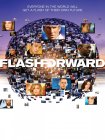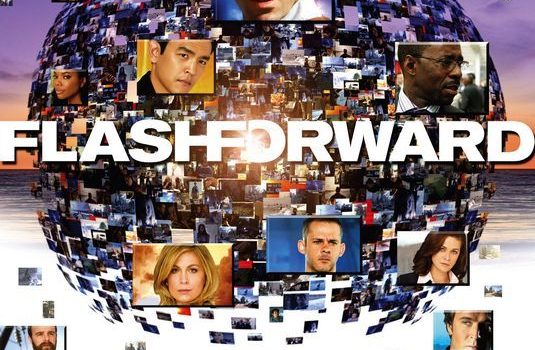Tomorrow Numbly Dies: A Final Look at FlashForward
by Gary Westfahl
 In an intensely complicated television series, grand visions may be inferred from the tiniest of details. During the frenetic final episodes of FlashForward’s first, and only, season, it is briefly noted that, according to the folks who have employed the technology of FlashForwards to repeatedly glimpse the future, no one has ever seen anything beyond a specific date sometime in 2016, provocatively suggesting that it might represent the end of the world. Were the creators and producers of the series, Brannon Braga and David S. Goyer, actually expecting, or dreaming, that their handiwork would endure into a seventh season, surpassing by one season the longevity of its most obvious progenitor, Lost (2004-2010), and allowing them to reveal the shocking truth in a spectacular, two-hour season finale sometime in May, 2016? This might explain the rather deliberate pace of its first ten episodes, each of which provided no more than one new revelation amidst much repetition and spinning of wheels.
In an intensely complicated television series, grand visions may be inferred from the tiniest of details. During the frenetic final episodes of FlashForward’s first, and only, season, it is briefly noted that, according to the folks who have employed the technology of FlashForwards to repeatedly glimpse the future, no one has ever seen anything beyond a specific date sometime in 2016, provocatively suggesting that it might represent the end of the world. Were the creators and producers of the series, Brannon Braga and David S. Goyer, actually expecting, or dreaming, that their handiwork would endure into a seventh season, surpassing by one season the longevity of its most obvious progenitor, Lost (2004-2010), and allowing them to reveal the shocking truth in a spectacular, two-hour season finale sometime in May, 2016? This might explain the rather deliberate pace of its first ten episodes, each of which provided no more than one new revelation amidst much repetition and spinning of wheels.
However, while they were meticulously laying the groundwork for their series’ epic run, the slow unfolding of its story was evidently baffling or boring viewers, leading to steadily declining ratings and ABC’s decision to take the series off the air for almost four months while producers endeavored to retool their product and make it more appealing. Unfortunately, while Braga and Goyer did manage to radically pick up the pace and make their later episodes more involving (for reasons to be discussed), ABC completely lost faith in FlashForward during its hiatus and made virtually no effort to promote its second incarnation. (Astonishingly, I recall seeing not a single commercial announcing and promoting its return.) It came as no surprise to anyone, then, when its cancellation was officially announced a few weeks before the final episode.
Certainly, even someone watching FlashForward on DVD with no knowledge of its history will be able to deduce that something significant happened to the series between its tenth and eleventh episodes; the two-part episode “Revelation Zero” that relaunched the series immediately displays a new sense of energy and purposefulness that makes one realize just how lethargically the previous episodes had proceeded. Further, in the course of firmly shifting the focus to the series’ most interesting character, quirky physicist Simon Campos (Dominic Monaghan), that episode also provides more information about the phenomenon of FlashForwards than all of the previous episodes combined. We are told that the worldwide blackout providing glimpses of six months into everyone’s future was indeed caused by a mysterious and powerful organization which carefully acted at the precise moment of the particle-accelerator experiment conducted by Campos and Lloyd Simcoe (Jack Davenport) so that the energy it generated would intensify the effects of the FlashForwards. This same organization also nurtured the young Campos and supported his groundbreaking research while benefiting from the expertise of another physicist, the elusive, purportedly-dead Dylan Frost (Michael Massee). Building upon these revelations, subsequent episodes would generally foreground how FBI agents Mark Benford (Joseph Fiennes), Demetri Noh (John Cho), Janis Hawk (Christine Woods), Shelly Vreede (Barry Shabaka Henley), and Stanford Wedeck (Courtney B. Vance), now accompanied by CIA agent Michael Ealy (Marshall Vogel), gradually learn more and more about how this organization developed the technology behind the FlashForwards while they seek to thwart their plan to effect a second blackout.
To be sure, there remain some irritating aspects of these later episodes. For one thing, even as Campos and the science behind the FlashForwards receive more attention, the producers cannot entirely avoid carrying on with their other storylines, which range from the engaging – the anticipated first meeting of soulmates Bryce Varley (Zachary Knighton) and Keiko Arahida (Yuko Takeuchi) – to the dull – the burgeoning romance between Simcoe and Benford’s wife Olivia (Sonya Walger) – to the risible – Aaron Stark (Brian O’Byrne) pursuing his kidnapped daughter Tracy (Genevieve Cortese), a soldier in Afghanistan who had pretended to be dead to escape the vengeance of the rogue security company, Jericho, whose atrocities she had observed. Even the thankfully minimal attention to the latter shenanigans is marred by an especially absurd twist: what Tracy saw was not the slaughter of innocent civilians, but an experimental FlashForward conducted by Jericho, now revealed to be part of this vast, evil conspiracy. (What are the odds that an FBI agent assigned to investigate the people behind the FlashForwards, recovering alcoholic Benford, would have been paired by Alcoholics Anonymous with a man whose daughter would happen to be a key witness to the conspirators’ actions?) Oh, and it also turns out that none other than the President of the United States, Dave Segovia (Peter Coyote), is somehow connected with Jericho, which presumably explains why he is destined to be replaced by Vice President Joyce Clemente (Barbara Williams) by the time observed in the FlashForwards, though the last episode has no time to deal with those peripheral characters.
The final episodes also are annoyingly filled with other contrived developments that display a certain amount of contempt for their audience. Essentially, Braga and Goyer are relying on a variation of the “idiot plot,” a term coined by James Blish and famously defined by Damon Knight as “a plot which is kept in motion solely by virtue of the fact that everybody involved is an idiot.” One may call their narrative a “conveniently-temporary idiot plot”; that is, this story involves a struggle between a brilliant, resourceful FBI office and a brilliant, resourceful international conspiracy, except that, when the plot requires it, members of both groups will temporarily act like complete idiots. As one egregious example, since Campos is the scientist whose research led to the FlashForwards, and since he is one of the few people who understands the science behind them, one would imagine that the organization that has him under their control would manage to hold on to him. But no; when it is time for Campos to reunite with the group that secretly supported his work, the FBI somehow allows him to be snatched by their enemies, and when it is time for him to return to the FBI, the conspirators somehow allow him to slip away. Other instances of this sort of stupidity are abundant: I cannot recall reading about any prisoner in federal custody managing to escape, let alone a dangerous terrorist, but the beautiful woman captured in the first episode gets away, so that she can assassinate Frost; and how it could be that the FBI would allow enemy agents not only to plant dangerous explosives inside its office, but to put them on every floor of their building? As for the sinister people responsible for the FlashForwards, their boundless ingenuity and ability to see the future somehow did not enable them to prevent the FBI from capturing a key leader, Lucas Hellinger (Neil Jackson), with a rather simple ploy.
Still, one must overlook such flaws to celebrate the one, astonishing virtue of this series’ final episodes: the fact that FlashForward actually evolves into a genuine work of science fiction.
One might attribute this surprising development, in part, to Robert J. Sawyer, whose 1999 novel Flashforward “inspired” the series. While Sawyer had always been credited as a “consultant” for the series, it is hard to imagine Braga and Goyer drawing upon his expertise while they were engendering the convoluted personal dramas that dominated the early episodes. But when the series’ struggle for survival seemed to require more attentiveness to Campos and the imagined science of the FlashForwards, they surely started talking to Sawyer. (Recalling that one prominent science fiction writer told me that, when the series Star Trek: Enterprise [2001-2005] was floundering, he had been approached by the producers, seeking ideas for reviving the series, I discern a pattern: as was not the case in the 1950s and 1960s, when television eagerly solicited ideas and scripts from established science fiction writers, contemporary producers turn to science fiction writers for guidance only when they are absolutely desperate.) As one sign of Sawyer’s input, the scientific gobbledygook explaining how the FlashForwards work sounds unusually persuasive (as one example, the magical ring that enables people to stay awake during blackouts is termed a “Quantum Entanglement Device”), and if this sounds like faint praise, one must remember that so many science fiction series do not even attempt to provide anything resembling plausible jargon. Sawyer was also invited to write one of the later episodes, “Course Correction,” which offers the series’ answer to the inevitable question posed by any depiction of characters peering into their futures: are people predestined to have certain fates, or do they have free will to choose any fate they desire? The episode’s ameliorative answer is that people are indeed able to prevent the particular events observed in their FlashForwards, or prevent their deaths as indicated by the absence of a FlashForward, but there remains a sort of cosmic karma that will tend to drive people toward similar destinies. So, a woman can avoid dying in one car accident, but may go on to die in another, entirely different car accident. (Rather stacking the deck in the episode, though, is one character who sets about to deliberately cause the deaths of several individuals who have apparently evaded their preordained demises.) Also, unusually suggesting some knowledge of literary predecessors, an episode co-written by Goyer and Lisa Zwerling is entitled “The Garden of Forking Paths,” referencing Jorge Luis Borges’s 1941 story of that name, which posited the simultaneous existence of innumerable possible futures that still might, at times, converge in similar ways.
More provocatively, the later episodes flesh out the technology of FlashForwards and their probable effects in precisely the manner of science fiction, as a permanent transformative element in future human society, and not a temporary aberration. Frost and his colleagues, it turns out, first conducted a series of experiments that caused a number of individuals, including the deranged Gabriel McDow (James Callis), to experience numerous FlashForwards, as shown in scenes that recalled, at least to me, Chris Marker’s short film La Jetée (1963), another story about the efforts of sinister scientists to obtain knowledge of the future by experimenting with unwilling subjects. (In Gabriel’s story, there is even a hint that they have brought about some form of actual time travel, since it is hard to see how he otherwise would have been able to be present in the background at so many events in Olivia’s life). Through these experiments, they have mastered the technique of repeatedly provoking FlashForwards, whether it is in single individuals, in large groups (like cities in Somalia and Afghanistan), or throughout the entire world. People within the organization have also employed this procedure to their own advantage; thus, Frost can scheme to prevent his own death because he has often observed the various ways that it might occur, while Hellinger and his colleagues have made themselves wealthy by taking advantage of information gleaned from FlashForwards (they invested heavily in dot.com companies and sold everything right before the dot.com market crashed; then they invested heavily in real estate and sold everything right before that market crashed). One gets an idea, in other words, of what it might be like to live in a world where all citizens, or at least some individuals, have the power to regularly look into their own futures. True, since all this activity involves people who are regarded as villains, there remains the suspicion that the creators were planning a denouément wherein, by means of the deaths of key characters, this knowledge would be implausibly erased from human memory in order to restore the status quo; nevertheless, they must be credited with developing the concept of FlashForwards much more than I had anticipated, and much more than Sawyer himself did in his novel.
Surprisingly, though, the series suggests at the same time that the ability to have FlashForwards might ultimately have little effect on human society; for despite his extensive foreknowledge, Frost proves unable to avoid being killed, and while Hellinger succeeds in getting rich from his glimpses into the future, he cannot prevent, as noted, his capture by the FBI. If individuals are indeed forced to follow certain preordained paths, with only the possibility of effecting minor variations, then the power to foresee one’s future might have few meaningful consequences, save to make desirable futures slightly more likely (since individuals will eagerly seek to make them occur) and to make undesirable futures slightly more unlikely (since individuals will urgently strive to avoid them). The only other difference might be that, obsessed with their envisioned futures, characters might be more inclined to make bad decisions in their presents. Thus, without any indication that he was likely to die, Demetri would surely have never endangered his relationship with fiancée Zoey Andata (Gabrielle Union) by being unfaithful; but convinced that his death was imminent, and anxious to leave some sort of legacy, he volunteers to become the father of Janis’s predicted baby, which naturally angers Zoey.
In the final episode, “Future Shock,” there is also the fascinating suggestion that people with some knowledge of their future will act less like people in charge of their own lives, and more like characters in a work of fiction, aware that they are supposed to do certain things and thus be determined to do them. Thus, even though her mother has previously opposed all of Keiko’s efforts to meet Bryce, she finally succumbs to the logic of letting her rush off to that restaurant where she is destined to meet him (and Bryce, of course, has gone there as well, and is happily admitted, even though the restaurant is occupied by a private party, because everybody is expecting him). The alcoholic Benford starts drinking again on the night of the blackout because he knows, from his FlashForward, that he will be drinking on that night. Lloyd Simcoe insists that Olivia and her daughter Charlie (Lennon Wynn) return to her house to be with him because he knows that he will have some sort of revelation there and believes that it requires everything to be in place exactly as he saw it, including Olivia’s presence. As the only character who seems to understand how silly all of this is, Olivia asks Lloyd, “So, how does this work? Just take our positions at 10 o’clock, wait for your breakthrough?” And she is soon standing at the top of the stairs in the right place while Lloyd is seated in the proper chair in the living room below. Since the envisioned scenes they are striving to reenact represent not only their own futures within the storyline, but also the fates that were crafted by the writers of the storyline, one can even regard FlashForward as a form of metaliterature involving characters in a work of fiction who discover that they are characters in a work of fiction being pushed toward a particular fate, with predecessors that include L. Ron Hubbard’s “Typewriter in the Sky” (1940) and the film Stranger Than Fiction (2006) (review here). This rather outré interpretation might provide the only reasonable answer to one significant puzzle: while it’s possible that I missed some hurried explanation, I cannot discern any reason why an international organization with the power to cause FlashForwards would repeatedly choose to inflict them upon the entire world, with catastrophic results. Surely, it would be in their best interests to quietly employ this technology to keep making themselves wealthier and more powerful; causing an international disaster only served to make the authorities aware of their existence and to ignite their furious efforts to oppose their every action. Yet one could say that these characters were informed by their creators, by means of FlashForwards, that they were destined to bring about these global blackouts, and hence undertook to do exactly what they were told to do.
The other great puzzle of FlashForward, perhaps never to be resolved, is the meaning of the last five minutes of “Future Shock,” written and filmed when producers still entertained hopes that their series might be renewed. Predictably, it involves a second worldwide blackout, occurring only minutes after characters arrive at the moment of their first FlashForwards. Again, we observe scenes of various people lying unconscious in various locales, although a woman wearing a ring wheels an unconscious Janis out of a hospital, while the kangaroo that enigmatically bounced through the streets of Los Angeles during the first FlashForward does its thing again. As for the chaotic glimpses of various FlashForwards displayed, it would seem that characters this time are viewing themselves on either March 14, 2011 (a date seen scribbled on a piece of paper) or January 1, 2015 (as suggested by a sign, “Happy New Year 2015”). Perhaps this indicates that this FlashForward will cause different people to see different times in the future; perhaps it only represents Braga and Goyer hedging their bets, prepared to develop a briefer story arc leading up to March, 2011 if they were renewed for only a second reason, but also ready to construct a grander narrative leading up to the year 2015 if they unexpectedly received a multi-season commitment. The snippets of FlashForwards – a boy in a swing, a baptism, a wedding, a gun being loaded, a will, someone being handed a key, a hospital document – may have been chosen at random, or may actually represent fully developed visions that were going to be assigned to various characters at the beginning of the second season; the only extended clip involves a teenage Charlie, evidently in the year 2015, happily announcing that “they found him,” a probable reference to the return of father Mark Benford from some misadventure. Will there ever be any brief continuation of the series, such as a miniseries or movie, to explain what all of this means and bring a sense of closure to this ill-fated series? To me, it certainly seems possible that this intermittently interesting series will develop a cult following after its DVD release and, like Joss Whedon’s Firefly (2002-2003), someday enjoy some sort of second life; however, lacking access to any technology to provoke FlashForwards, I can provide no definitive predictions.










A great article. Agree with most of your points and enjoyed reading a deep analysis into a great show that unfortunately didn’t have ABC’s trust alongside it.
I am upset this show was cancelled. I hope another network picks it up.
Pingback:Tweets that mention Locus Online Reviews » Tomorrow Numbly Dies: A Final Look at FlashForward -- Topsy.com
Pingback:Tomorrow Numbly Dies: A Final Look at FlashForward – Locus Online | Past present future ring
Brannon Braga was cocreator and cowriter on the pilot, but left (or was pushed) after that. Why is Westfahl still babbling about him?
Another blackout was totally predictable because there was another one in the novel.
The series’ confusion about how the future does not necessarily come true (rendering the flashforwards irrelevant) but they sort of do (however does that work?) comes from the novel as well.
Pingback:Tomorrow Numbly Dies: A Final Look at FlashForward | Something For Everyone
Pingback:michael ealy | TrendyTwits